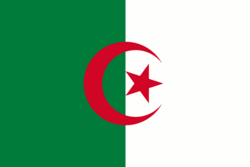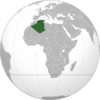Knowledge fuels change - Support energypedia!
For over 10 years, energypedia has been connecting energy experts around the world — helping them share knowledge, learn from each other, and accelerate the global energy transition.
Today, we ask for your support to keep this platform free and accessible to all.
Even a small contribution makes a big difference! If just 10–20% of our 60,000+ monthly visitors donated the equivalent of a cup of coffee — €5 — Energypedia would be fully funded for a whole year.
Is the knowledge you’ve gained through Energypedia this year worth €5 or more?
Your donation keeps the platform running, helps us create new knowledge products, and contributes directly to achieving SDG 7.
Thank you for your support, your donation, big or small, truly matters!
Algeria Energy Situation
Overview
| People's Democratic Republic of Algeria | |||
| |
| ||
|
Capital |
Algiers (36°42′N 3°13′E) | ||
|
Official language(s) |
Arabic | ||
|
Government |
Semi-presidential republic | ||
|
President |
Abdelaziz Bouteflika | ||
|
Prime Minister |
Ahmed Ouyahia | ||
|
Total area |
2,381,741 km2 | ||
|
Population |
35,423,000 (2010 estimate) | ||
|
GDP (nominal) |
$158.969 billion | ||
|
GDP Per capita |
$4,478 | ||
|
Currency |
Algerian dinar (DZD) | ||
|
Time zone |
CET (UTC+01) | ||
|
Calling code |
+213 | ||
Algeria is located in North Africa and is bordering Tunisia and Libya in the east, Niger and Mali in the south, and Mauritania, Western Sahara, and Morocco in the west. In the north, Algeria’s vast coast of over 1.200 km extends to the Mediterranean Sea. Being part of the Maghreb, Algeria is furthermore considered to be a part of the MENA-region. With its more than two million km2 of national territory, Algeria is by far the largest North African country. However, most of its national territory is being occupied by the Sahara, which thus explains the population of roughly 33 million people.[1] This is also expressed in the arrangement of population density: 90% of the population is located in the north.[2] The mild Mediterranean climate coming from the coast is being replaced by a dry desert climate while moving south. The official language is Arabic, although French can be considered to be a common lingua franca, whereas in some areas Berber dialects can be common as well.[3] Having a parliament that consists of a national assembly and a senate, Algeria is a republic with Abdelaziz Bouteflika, who has been reelected with 90.2% of votes in 2009,[4] as its president since 1999.[5] Ethnic groups are made up of a vast majority of Arab-Berber (99%). However, most Algerians identify themselves with their Berber heritage rather than their Arab one.[6] The state religion is Sunni Muslim, likewise represented by a vast majority, while Christians and Jews make up less than 3% of the population.[7]
Minerals that can be found in this region are amongst others oil, gas, iron, and lead.[8] Together with agricultural goods, they make up the majority of export goods. Furthermore, they are the reason, why Algeria is part in international economic conglomerates, such as the OPEC or the OAPIC. Algeria’s gross domestic product (GDP) has been constantly rising in the last couple of years, bringing it to the approximate amount of $160 billion in 2010. The GDP per capita is hence about $7.3.[9]
Algeria has a number of transnational issues to deal with, including an international dispute with the Moroccan administration of Western Sahara and illegal schemes in form of smuggling, human trafficking and forced labor.[10]
Energy situation
Energy Supply
In 2008, Algeria has produced a total amount of 162,044 ktoe of energy, which is about 1,884,571 GWh. Its main energy source is crude oil (54.4%), followed by gas (45.5%). In comparison, the numbers concerning the renewable energies are much smaller and close to zero. Other energy sources, such as coal, nuclear power or heat are in fact zero, thus giving an impression that Algeria has quite a unilateral energy landscape. Published by the International Energy Agency (IEA), the numbers below offer more detail to Algeria's energy production:
|
Energy Source |
in ktoe |
in % |
|---|---|---|
|
Coal and Peat |
0 |
0 |
|
Crude Oil |
88,187 |
54.4 |
|
Oil Products |
0 |
0 |
|
Gas |
73,783 |
45.5 |
|
Nuclear |
0 |
0 |
|
Hydro |
24 |
0.02 |
|
Geothermal, solar, etc. |
0 |
0 |
|
Combustible renewables and waste |
49 |
0.03 |
|
Electricity |
0 |
0 |
|
Heat |
0 |
0 |
|
Total1 |
162,044 |
Table 1: Total Energy Production of Algeria (2008)
Source: International Energy Agency, ©2011, "2008 Energy Balance for Algeria", Last Updated: - , Accessed: September 19, 2011, URL: ">http://www.iea.org/stats/balancetable.asp?COUNTRY_CODE=DZ http://www.iea.org/stats/balancetable.asp?COUNTRY_CODE=DZ">http://www.iea.org/stats/balancetable.asp?COUNTRY_CODE=DZ
Taking Table 1 above into consideration, Table 2 ("Total Primary Energy Supply") offers quite a similar picture. It might yet seem suprising, that gas is now the main energy source with more than 60%, while oil only makes up 37% of the energy supply. This curiosity can be explained by the massive amount of crude oil (-55,002 ktoe) and oil products (-19,334 ktoe) Algeria is exporting and thus decreasing the amount of available oil.[11] Plenty of gas is being exported, as well (-51,259 ktoe).[12]
|
Energy Source |
in ktoe |
in % |
|---|---|---|
|
Coal and Peat |
755 |
2.0 |
|
Oil |
13,721 |
37.0 |
|
Gas |
22,524 |
60.8 |
|
Nuclear |
0 |
0.0 |
|
Hydro |
24 |
0.01 |
|
Geothermal, solar, etc. |
0 |
0.0 |
|
Combustible renewables and waste |
49 |
0.1 |
|
Electricity |
-4 |
-0.1 |
|
Heat |
0 |
0.0 |
|
Total1 |
37,069 |
Table 2: Total Primary Energy Supply of Algeria (2008)
1Total may not add up due to roundings.
Source: International Energy Agency, ©2011, "2008 Energy Balance for Algeria", Accessed: September 19, 2011, URL: ">http://www.iea.org/stats/balancetable.asp http://www.iea.org/stats/balancetable.asp?COUNTRY_CODE=DZ">http://www.iea.org/stats/balancetable.asp? COUNTRY_CODE=DZ
Electricity
In the course of the last decade, electricity production rose from 26,250 GWh in 2001 to a predicted increase to up to 46,000 GWh in 2010.[13] It appears that this development is mainly due to the economic growth that Algeria has experienced along the way.[14] As Table 3 shows below, main source for the production of electricity is gas with a relativ percentage to the total amount produced of over 97%. Although there are other minor sources of electricity, such as oil and hydro-power, a similar picture as seen in the tables above is being created, suggesting a rather one-sided production and supply (in this case) of electricity.
|
Energy Source |
in GWh |
in %2,3 |
|---|---|---|
|
Coal |
0 |
0.0 |
|
Oil |
792 |
2.0 |
|
Gas |
39,161 |
97.3 |
|
Biomass |
0 |
0.0 |
|
Waste |
0 |
0.0 |
|
Nuclear |
0 |
0.0 |
|
Hydro |
283 |
0.7 |
|
Geothermal |
0 |
0.0 |
|
Solar PV |
0 |
0.0 |
|
Solar thermal |
0 |
0.0 |
|
Wind |
0 |
0.0 |
|
Tide |
0 |
0.0 |
|
Other sources |
0 |
0.0 |
|
Total Production |
40,236 |
100.0 |
|
Imports |
274 |
0.7 |
|
Exports |
-323 |
-0.8 |
|
Domestic Supply |
40,187 |
99.9 |
Table 3: Electricity Production and Supply of Algeria (2008)
2In relation to the amount given by "Total Production"
3Total may not add up due to roundings and overlapping percentages.
Source: International Energy Agency, ©2011, "Electricity/Heat in Algeria 2008", Last updated: - , Accessed: September 20, 2011, URL: http://www.iea.org/stats/electricitydata.asp?COUNTRY_CODE=DZ
Energy Consumption
Compared to 2008, Algeria has increased its energy consumption in 2009 by almost 5%.[15] In 2008, Algeria's total final consumption (TFC) added up to 23,447 ktoe units, equal to 272,688.6 GWh.
|
Sector |
Consumption in GWh |
in % |
|---|---|---|
|
Industry |
51,381.3 |
18,8 |
|
Transport |
79,770.2 |
29.3 |
|
Residential |
117,323.4 |
43.0 |
|
Non-energy use |
24,213.7 |
8.9 |
|
TFC |
272,688.6 |
100 |
Table 4: Algeria's TFC of Energy (2008)
Source: International Energy Agency, ©2011, "Electricity/Heat in Algeria 2008", Last updated: - , Accessed: September 20, 2011, URL: http://www.iea.org/stats/balancetable.asp?COUNTRY_CODE=DZ
Energy demand
Type your text here
Electricity
Type your text here
Access rate
Type your text here
Market situation for different energy technologies and services
Solar Energy
Type your text here
Wind Energy
Type your text here
Biomass
Type your text here
Biogas
Type your text here
Hydro Power
Type your text here
Other renewable Sources
Type your text here
Key problems of the energy sector
Type your text here
Policy framework, laws and regulations
Type your text here
General Energy policy, Energy strategy
Type your text here
Important Laws and regulations
Type your text here
Specific strategies (Biomass, renewable energies, rural electrification, energy access strategy etc.)
Type your text here
Institutional set up in the energy sector
Type your text here
Governmental institutions Private sector (enterprises, NGOs)
Type your text here
Activities of other donors, activities of NGOs
Type your text here
Existing projects
Type your text here
Further Reading
Type your text here
External links
Reference list
- ↑ Auswärtiges Amt (German Ministry of Foreign Affairs), Last Updated: October, 2010, Access: September 16, 2011, URL: http://www.auswaertiges-amt.de/DE/Aussenpolitik/Laender/Laenderinfos/01-Nodes_Uebersichtsseiten/Algerien_node.html
- ↑ Deutsche Außenhandelskammer (German Chamber of Foreign Trade - AHK), Last Updated: 2011, Access: September 16, 2011, URL: http://algerien.ahk.de/algerien/
- ↑ Central Intelligence Agency (CIA) - World Factbook, Last Updated: August 23, 2011, Accessed: September 16, 2011, URL: https://www.cia.gov/library/publications/the-world-factbook/geos/ag.html
- ↑ Central Intelligence Agency (CIA) - World Factbook, Last Updated: August 23, 2011, Accessed: September 16, 2011, URL: https://www.cia.gov/library/publications/the-world-factbook/geos/ag.html
- ↑ Auswärtiges Amt (German Ministry of Foreign Affairs), Last Updated: October, 2010, Access: September 16, 2011, URL: http://www.auswaertiges-amt.de/DE/Aussenpolitik/Laender/Laenderinfos/01-Nodes_Uebersichtsseiten/Algerien_node.html
- ↑ Central Intelligence Agency (CIA) - World Factbook, Last Updated: August 23, 2011, Accessed: September 16, 2011, URL: https://www.cia.gov/library/publications/the-world-factbook/geos/ag.html
- ↑ Auswärtiges Amt (German Ministry of Foreign Affairs), Last Updated: October, 2010, Access: September 16, 2011, URL: http://www.auswaertiges-amt.de/DE/Aussenpolitik/Laender/Laenderinfos/01-Nodes_Uebersichtsseiten/Algerien_node.html
- ↑ Deutsche Außenhandelskammer (German Chamber of Foreign Trade - AHK), Last Updated: 2011, Access: September 16, 2011, URL: http://algerien.ahk.de/algerien/
- ↑ Central Intelligence Agency (CIA) - World Factbook, Last Updated: August 23, 2011, Accessed: September 16, 2011, URL: https://www.cia.gov/library/publications/the-world-factbook/geos/ag.html
- ↑ Central Intelligence Agency (CIA) - World Factbook, Last Updated: August 23, 2011, Accessed: September 16, 2011, URL: https://www.cia.gov/library/publications/the-world-factbook/geos/ag.html
- ↑ International Energy Agency, ©2011, "2008 Energy Balance for Algeria", Last Updated: - , Accessed: September 19, 2011, URL: http://www.iea.org/stats/balancetable.asp?COUNTRY_CODE=DZ
- ↑ International Energy Agency, ©2011, "2008 Energy Balance for Algeria", Last Updated: - , Accessed: September 19, 2011, URL: http://www.iea.org/stats/balancetable.asp?COUNTRY_CODE=DZ
- ↑ Ministère de l'Energie et des Mines (MEM), Last Updated: - , Accessed: September 20, 2011, URL: http://www.mem-algeria.org/francais/index.php?page=perspectives-de-developpement
- ↑ Ministère de l'Energie et des Mines (MEM), Last Updated: - , Accessed: September 20, 2011, URL: http://www.mem-algeria.org/francais/index.php?page=perspectives-de-developpement
- ↑ Ministère de l'Energie et des Mines (2010), "Bilan Energetique National de l'année 2009", pg. 19.





















